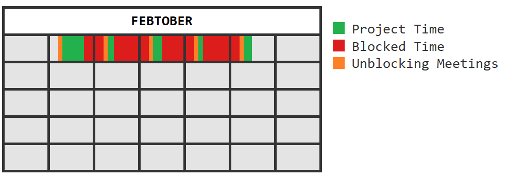Why blockers?
With this article, I will show you the astronomical cost of blockers and provide you with a mental model for how to think about them. We’ll discuss a couple of strategies to get you started with addressing them. When applied, the tips will make you absurdly more effective, regardless of who you are and what you do.
A blocker is anything which prevents you from moving forward (mentally, physically, emotionally, or otherwise). Maybe you’re stuck on a tough problem and don’t know how to move forward. Or you’re waiting on someone else. Maybe you’re waiting on missing parts. Perhaps you’re emotionally torn between two outcomes. It might be that you’re procrastinating a hard decision. Either way, a blocker prohibits us from progress.
A simple formula
Whatever it looks like for you, you may be surprised to know that you could get more done by optimizing the resolution of blockers. Not 5% more, but 5 times more! Consider the following simple formula:
(Total Project Time) = (Time Spent on the Project) + (Time Spent Blocked)
For most, Time Spent Blocked vastly exceeds Time Spent on the Project. For people and projects in this paradigm, the time spent on the project has almost zero impact.
If you want to decrease your time spent on projects, you should focus all your energy on the time spent blocked (at least while this paradigm holds).
In other words: the project duration is essentially the accumulated amount of time spent in the blocked state.
Example

Notice here that most of your time is spent blocked, about 95%. Notice also that the project takes about a month to complete.
Options for optimizing blockers
Option 1 – Introduce a daily standup
A daily standup can be an excellent opportunity to remove blockers with greater frequency. Introducing a short daily standup can significantly reduce the amount of time spent blocked.

There’s a lot less red on this calendar at the cost of more frequent meetings.
Here you are blocked for about 73% of your time, a bit of a reduction, but the real gain here is that the project is now completed within the week, about 4x faster than before. Consequently, you can now fit 4x more projects into your month. To really drive this home, you can now deliver value 4x faster.
There’s been plenty written on the best practices of stand ups. Typically, all members of a team show up and rapidly share their blockers, but crucially do not solve them. The intention of the meeting is to create awareness and coordinating a follow-up immediately after the meeting to resolve the blocker. The goal is to keep the meeting under 15 minutes, and the recommendation is to have the team physically stand up so as to incentivize a speedier resolution. Typically a daily standup occurs at the beginning of the day so that it does not distract the team from what they are working on.
Option 2 – Immediate blocker resolution
Another alternative is to eliminate the blockers immediately when they arise. This would involve creating a process to escalate blockers until they are solved. (Be cautious about using this method)

With this method your project could be resolved in about a day and a half!
For this project, you are blocked 31% of your time (the maximum efficiency for this example project). More importantly, this is method allows you to complete the project about 20x faster than the original option. If you’re able to create a process for operating your team like this all the time, you would see a 20x increase in the velocity of projects. For large teams with many projects this may be infeasible and unadvisable.
This methodology has the potential to be very dangerous and should be used with great care. It requires intense project management and over-communication. If this type of process is abused/overused you can massively distract your team and have the exact opposite of the intended effect.
That being said, this is an incredibly powerful tool when used correctly. I recommend using this when a particular project blocks the whole organization, the whole department, or the whole team. When a project is operating at this level, we call them Critical Projects. We give people in charge of these projects extra authority to command other team members and extra channels to escalate their blockers up through the organization/department/team.
When asked, we drop everything to assist with removing blockers for Critical Projects. Team members in charge of these projects are explicitly told they are working on a Critical Project and are reminded of their authority, the responsibility, and the cost of delays. If they delegate work for this project, they should also delegate this authority. This ensures that large projects that can stall the organization/department/team are always moving at maximum velocity, and since not every project has this level of authority, we retain control over the chaos.
As a side note, this was the first time we saw that the project spent less than 50% of the time in the blocked state. Up to this point it made little sense to optimize anything but the blockers. Now the time spent optimizing the work on the project themselves would begin to make sense.
There are plenty of solutions in and outside of these two methods. The important thing is to spend energy on the root of where your projects are stuck and optimize it. It’s amazing how much faster you could go thinking about this in terms of blockers.
Other applications of the mental model
As alluded to earlier, projects aren’t the only things that you can map this concept onto.
Perhaps you have a crucial conversation you are procrastinating, sharing the feedback immediately means that the time spent in the uncertain state is negligible. You’ll have to deal with the outcome of the conversation eventually so why not get on with it and save yourself the time.
Maybe you’re in a negotiation or a long sales cycle. In these scenarios, the ball is in the other court for some significant amount of time. You don’t have control over how much time the opposing party takes, but you can control the number of decisions they have to make while the ball is with them. You have control over how long your party takes. You have control over setting the expectations. Spend some energy on your plan of attack to minimize the number of times the ball lands in their court and see what you can do about how long it stays there. It will pay out substantial multiples.
Or let’s say you deal with client-facing work. Having some prescience about the blockers you may run into with a client and preempting these blockers will pay off multiple times over. This type of work suffers from the same problems in the previous example. Generally, the less frequently that work lives with the client and the less turnaround time it takes on average translates directly to more projects per year, which means more profit to reinvest in a larger team, which means more projects which means exponential growth.
Summary
The time it takes to complete projects is controlled largely by the time spent in the blocked state. Being aware of when you are blocked and implementing systems to minimize the blocking state can help you maximize productivity. As we’ve shown here and in other blog posts, maximizing productivity can lead to 10x improvements and which leads to compounding growth. A small investment here can result in outsized improvements in short order and pay dividends over a lifetime.
At Meetings.io we believe an efficient meeting is a lever for creating an efficient organization. More than meeting agenda software, we’ve built tools with philosophy at its core. Give us a try and see how much of an impact a great meeting can have with your team.
Written by
Clay

